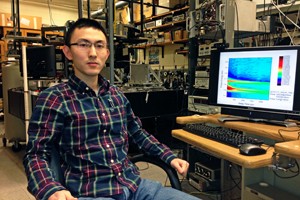
How 19th Century Physics Could Change the Future of Nanotechnology
A new twist on a very old physics technique could have a profound impact on one of the most buzzed-about aspects of nanoscience.
Researchers at the University of Cincinnati have found that their unique method of light-matter interaction analysis appears to be a good way of
helping make better semiconductor nanowires
.
"Semiconductor nanowires are one of the hottest topics in the nanoscience research field in the recent decade," says Yuda Wang, a UC doctoral student. "Due to the unique geometry compared to conventional bulk semiconductors, nanowires have already shown many advantageous properties, particularly in novel applications in such fields as nanoelectronics, nanophotonics, nanobiochemistry and nanoenergy."
Wang will present the team's research "
Transient Rayleigh Scattering Spectroscopy Measurement of Carrier Dynamics in Zincblende and Wurtzite Indium Phosphide Nanowires
" at the
American Physical Society (APS) meeting
to be held March 3-7 in Denver. Nearly 10,000 professionals, scholars and students will attend the APS meeting to discuss new research from industry, universities and laboratories from around the world.
Key to this research is UC's new method of Rayleigh scattering, a phenomenon first described in 1871 and the scientific explanation for why the sky is blue in the daytime and turns red at sunset. The researchers' Rayleigh scattering technique probes the band structures and electron-hole dynamics inside a single indium phosphide nanowire, allowing them to observe the response with a time resolution in the femtosecond range or one quadrillionth of a second.
"Basically, we can generate a live picture of how the electrons and holes are excited and slowly return to their original states, and the mechanism behind that can be analyzed and understood," says Wang, of UC's
. "It's all critical in characterizing the optical or electronic properties of a semiconducting nanowire."
Semiconductors are at the center of modern electronics. Computers, TVs and cellphones have them. Theyre made from the crystalline form of elements that have scientifically beneficial electrical conductivity properties.
Wang says the burgeoning range of semiconductor nanowire applications such as smaller, more energy-efficient electronics has brought rapid improvement to nanowire fabrication techniques. He says his team's research could offer makers of nanotechnology
a new and highly effective option for measuring the physics inside nanowires
.
"The key to a good optimization process is an excellent feedback, or a characterization method," Wang says. "Rayleigh scattering appears to be an exceptional way to measure several nanowire properties simultaneously in a non-invasive and high-quality manner."
Additional contributors to this research are UC alumnus Mohammad Montazeri; UC physics professors Howard Jackson and Leigh Smith and adjunct associate professor Jan Yarrison-Rice, all of the
McMicken College of Arts and Sciences
; and Tim Burgess, Suriati Paiman, Hoe Tan, Qiang Gao and Chennupati Jagadish of Australian National University.
This effort is part of
substantial research on semiconductor nanowires at UC
that is partially funded by the National Science Foundation. The team at UC is one of only about a half dozen in the U.S. conducting competitive research in the field. The team's big achievements in the science of small support the
by producing new ways of understanding and transforming the world through research and scholarship.
Related Stories
Preventable loss: A billion birds die each year from window...
May 13, 2024
A biologist with the University of Cincinnati is raising public awareness about ways to keep birds from striking windows, a national problem that is leading to alarming declines in populations.
The Verge: The teens making friends with AI chatbots
May 9, 2024
Kelly Merrill, an assistant professor of health communications and technology in the University of Cincinnati's College of Arts and Sciences, was cited in an article on teen use of AI chatbots for friendship and therapy purposes. Merrill, who studies the mental and social health benefits of communication technologies, told The Verge that extensive research has been conducted on AI chatbots that provide mental health support, and the results are largely positive.
Patrick S. Portway receives A&S Distinguished Alumni Award
May 9, 2024
The Distinguished Alumni Award is given to an established alumnus who is outstanding in their chosen field and whose significant contributions have benefited the community, state, nation, college or university.
